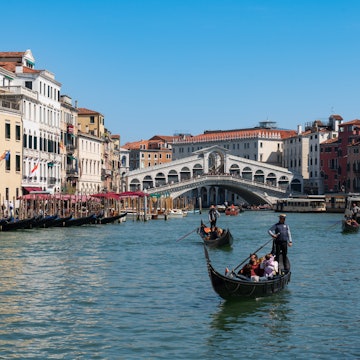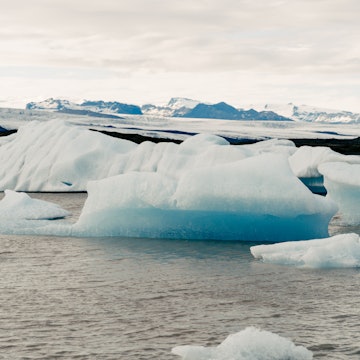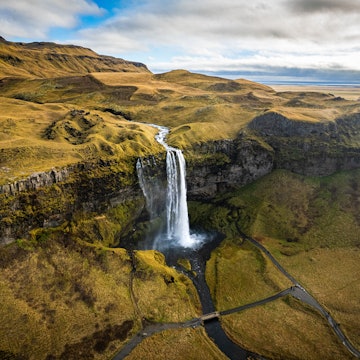

The Laugavegur Trail near Alftavatn. Natalia Moroz / Getty Images
With black volcanic deserts and verdant valleys, steaming geothermal springs and glacial rivers, plummeting ravines and precipitous ridges, it's no wonder Iceland's Laugavegur Trail is such a legendary hiking trail.
On top of the spectacular, otherworldly landscape, it's comfortably doable in a week, including flying in and out of Reykjavik. So what should you bring to make the most of it?
Getting your bearings
For many, their first Icelandic adventure will be the Laugavegur Trail - and with very good reason. The Laugavegur stretches some 53km, starting at Landmannalaugar Hut and trekking south over 4 days to huts at Hrafntinnusker, Alftavatn and Emstrur ending at Þórsmörk. (The character "Þ" is sometimes written as "Th" to add a linguistic twist.) Many hikers bolt on an additional day taking Fimmvorduhals Pass to the coast, culminating at the dramatic Skogafoss Waterfall.
Plan out every piece of your wardrobe
Iceland's geography and climate is no joke – the hoary old chestnut that ‘there’s no such thing as bad weather, only bad equipment’ finds full expression here. You need to be prepared for all conditions. This is a demanding hike, at times isolated, and the volatile weather can amplify that challenge.
Good quality, waterproof hiking boots that have already been broken in are essential here, as are decent walking socks. Put your feet in a pair of boots from Meindl or Salomon and you can’t go far wrong. Thin sock liners are a good idea when trekking on consecutive days – they’ll help reduce boot friction and the risk of blisters. Plus they keep your extremities toastier too. It’s also good habit to have spare laces in your pack.
A breathable waterproof jacket is a must, but be sure to pack some waterproof trousers as well (South Iceland gets buckets of Atlantic-fed rain). Look for outerwear with Gore-Tex: it’s still the go-to waterproofing technology for most reputable brands and offers great protection with surprising breathability. You will also need a thermal base top and bottoms. Merino wool, a natural super-fabric is simply the best – Icebreaker has a great range. This will leave you free to layer additional options like a packable down jacket, fleece and tops. Add hiking trousers or shorts and leggings if that's more your style, and make sure everything is wickable – nothing cotton. Always have a warm hat and gloves, while many also enjoy the flexibility of a Buff to keep the wind out.
On your back
Depending on what sort of trip you're on, luggage requirements vary. Solo travellers will carry everything with them, so a sturdy 65L backpack with good support is ideal. All your food will have to be in there too, so allow about 10L of space for that. The Laugavegur is a well-trodden route, where huts will be busy during peak season, mid-Summer. But out on the trail, you’ll often find great stretches of epic wilderness all to yourself.
On the other hand, if you're trekking with a guided, organised group, there's usually some sort of monster-wheeled SUV or minibus (check out trips offered by amazingtours.is or Lonely Planet partners like G Adventures and Viator) which goes ahead between huts with your main bag, where a 65L expedition duffle makes sense. Meanwhile, a 25L day pack works great for your own hikes between the huts, carrying spare layers, water, packed lunch, hot drink, first aid kit, togs and your camera/phone etc.
Amphibious expeditions
Expect a number of rivers to be waded on this trip – you'll likely have to cross Bratthálshvísl near Hvanngil, or Þrönga before Þórsmörk. Pay attention to your guides or be sure to do some homework on how to cross safely. Topped up by heavy rain and glacial meltwater, these can often be fast-flowing and thigh-high or deeper, with loose gravelly banks and deceptive plunges.
Out here, a fall in icy cold water brings much more serious than mere embarrassment. With the wind chill, hypothermia from a soaking is a considerable risk. Sandals with straps or neoprene booties are crucial as the river bed can too rough and slippery for bare feet. Cross in twos or threes, with arms linked at the elbow. Poles can be useful for balance. Tie everything on securely: you don't want to get over successfully only to find one of your gloves is flashing its way downstream.
Don't forget your togs
Bring a swimsuit and keep it handy, even on your way from Keflavik Airport. A popular diversion en route to Reykjavik is the Blue Lagoon, a touristy but nonetheless enjoyable introduction to the country's remarkable geothermal resources. You'll get plenty of use out of your swimsuit on the trail too, as Laugavegur's translation approximates to ‘the way of hot pools’ with naturally simmering ponds inviting a soothing dip along the way.
Sleeping tight
Accommodation in the huts is shared dorms, with rubber mattresses, so you can skip bringing a sleeping pad. You will need at least a 3/4 season sleeping bag. If you sleep cold, a bag liner notches up a couple more degrees. Because there's a ‘boots off’ rule in the huts, which are usually impeccably maintained, a pair of runners or sandals for indoor use only is useful.
Other hardware
Self navigators should pack a handheld GPS, preferably with mapping, with a map and compass as backup. The route is marked, but fog and mist are common risks out here; storms and floods can wash away markings. So prepare well and always leave trip details with someone, including your expected arrival time.
Walking poles reduce the knee load and can help wading rivers. A head torch is essential for outdoors night-time lavatory jaunts and bedtime reading. And on the subject of paperwork, don't forget loo roll.

Waterproof hiking boots with ankle support; spare laces
Waterproof breathable shell jacket and trousers
Packable down jacket and fleece
Quick-dry hiking trousers
Long/short sleeve tops - wickable; more layers rather than thicker ones
Good walking socks and sock liners
Warm hat and gloves
Thermals (top & bottom)
Packable towel – in your day pack for rivers/springs
Sandals with straps or neoprene socks/booties for wading
Indoors shoes
Walking poles
Head torch – for outdoors night-time lavatory jaunts and bedtime reading
Dry bag – expect heavy rain at some stage; keep spare socks and layers dry for changes en route
Water bottle
Small Thermos Flask – a hot drink on a wet day can change the picture
3/4 season sleeping bag; liner option
Ear plugs – keep out the dorm snorers
Swimsuit
First aid kit, including prescriptions, blister treatment and survival blanket
Personal toiletries, wet wipes, loo roll
Sunglasses and sun protection
GPS/Map/Compass if navigating
All your food if you're not with an organised group















